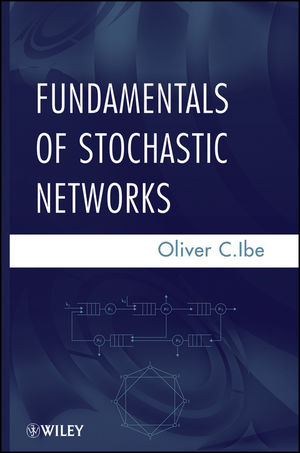
Fundamentals of Stochastic Networks
John Wiley & Sons Inc (Verlag)
978-1-118-06567-9 (ISBN)
An interdisciplinary approach to understanding queueing and graphical networks In today's era of interdisciplinary studies and research activities, network models are becoming increasingly important in various areas where they have not regularly been used. Combining techniques from stochastic processes and graph theory to analyze the behavior of networks, Fundamentals of Stochastic Networks provides an interdisciplinary approach by including practical applications of these stochastic networks in various fields of study, from engineering and operations management to communications and the physical sciences.
The author uniquely unites different types of stochastic, queueing, and graphical networks that are typically studied independently of each other. With balanced coverage, the book is organized into three succinct parts:
Part I introduces basic concepts in probability and stochastic processes, with coverage on counting, Poisson, renewal, and Markov processes
Part II addresses basic queueing theory, with a focus on Markovian queueing systems and also explores advanced queueing theory, queueing networks, and approximations of queueing networks
Part III focuses on graphical models, presenting an introduction to graph theory along with Bayesian, Boolean, and random networks
The author presents the material in a self-contained style that helps readers apply the presented methods and techniques to science and engineering applications. Numerous practical examples are also provided throughout, including all related mathematical details.
Featuring basic results without heavy emphasis on proving theorems, Fundamentals of Stochastic Networks is a suitable book for courses on probability and stochastic networks, stochastic network calculus, and stochastic network optimization at the upper-undergraduate and graduate levels. The book also serves as a reference for researchers and network professionals who would like to learn more about the general principles of stochastic networks.
OLIVER C. IBE, ScD, is Associate Professor in the Department of Electrical and Computer Engineering at the University of Massachusetts at Lowell. He has more than thirty years of experience in academia and the telecommunications industry in various technical and management capacities. Dr. Ibe's research interests include stochastic systems modeling, bioinformatics, and communication network performance modeling. He is the author of Converged Network Architectures: Delivering Voice over IP, ATM, and Frame Relay (Wiley).
Preface xi Acknowledgments, xii
1 Basic Concepts in Probability 1
1.1 Introduction, 1
1.2 Random Variables, 1
1.3 Transform Methods, 5
1.4 Covariance and Correlation Coefficient, 8
1.5 Sums of Independent Random Variables, 8
1.6 Random Sum of Random Variables, 9
1.7 Some Probability Distributions, 11
1.8 Limit Theorems, 21
2 Overview of Stochastic Processes 26
2.1 Introduction, 26
2.2 Classification of Stochastic Processes, 27
2.3 Stationary Random Processes, 27
2.4 Counting Processes, 28
2.5 Independent Increment Processes, 29
2.6 Stationary Increment Process, 29
2.7 Poisson Processes, 30
2.8 Renewal Processes, 32
2.9 Markov Processes, 37
2.10 Gaussian Processes, 56
3 Elementary Queueing Theory 61
3.1 Introduction, 61
3.2 Description of a Queueing System, 61
3.3 The Kendall Notation, 64
3.4 The Little’s Formula, 65
3.5 The M/M/1 Queueing System, 66
3.6 Examples of Other M/M Queueing Systems, 71
3.7 M/G/1 Queue, 79
4 Advanced Queueing Theory 93
4.1 Introduction, 93
4.2 M/G/1 Queue with Priority, 93
4.3 G/M/1 Queue, 99
4.4 The G/G/1 Queue, 105
4.5 Special Queueing Systems, 109
5 Queueing Networks 124
5.1 Introduction, 124
5.2 Burke’s Output Theorem and Tandem Queues, 126
5.3 Jackson or Open Queueing Networks, 128
5.4 Closed Queueing Networks, 130
5.5 BCMP Networks, 132
5.6 Algorithms for Product-Form Queueing Networks, 138
5.7 Networks with Positive and Negative Customers, 144
6 Approximations of Queueing Systems and Networks 150
6.1 Introduction, 150
6.2 Fluid Approximation, 151
6.3 Diffusion Approximations, 155
7 Elements of Graph Theory 172
7.1 Introduction, 172
7.2 Basic Concepts, 172
7.3 Connected Graphs, 177
7.4 Cut Sets, Bridges, and Cut Vertices, 177
7.5 Euler Graphs, 178
7.6 Hamiltonian Graphs, 178
7.7 Trees and Forests, 179
7.8 Minimum Weight Spanning Trees, 181
7.9 Bipartite Graphs and Matchings, 182
7.10 Independent Set, Domination, and Covering, 186
7.11 Complement of a Graph, 188
7.12 Isomorphic Graphs, 188
7.13 Planar Graphs, 189
7.14 Graph Coloring, 191
7.14.1 Edge Coloring, 191
7.14.2 The Four-Color Problem, 192
7.15 Random Graphs, 192
7.16 Matrix Algebra of Graphs, 195
7.17 Spectral Properties of Graphs, 198
7.18 Graph Entropy, 201
7.19 Directed Acyclic Graphs, 201
7.20 Moral Graphs, 202
7.21 Triangulated Graphs, 202
7.22 Chain Graphs, 203
7.23 Factor Graphs, 204
8 Bayesian Networks 209
8.1 Introduction, 209
8.2 Bayesian Networks, 210
8.3 Classification of BNs, 214
8.4 General Conditional Independence and d-Separation, 215
8.5 Probabilistic Inference in BNs, 215
8.6 Learning BNs, 227
8.7 Dynamic Bayesian Networks, 231
9 Boolean Networks 235
9.1 Introduction, 235
9.2 Introduction to GRNs, 236
9.3 Boolean Network Basics, 236
9.4 Random Boolean Networks, 238
9.5 State Transition Diagram, 239
9.6 Behavior of Boolean Networks, 240
9.7 Petri Net Analysis of Boolean Networks, 242
9.8 Probabilistic Boolean Networks, 250
9.9 Dynamics of a PBN, 251
9.10 Advantages and Disadvantages of Boolean Networks, 252
10 Random Networks 255
10.1 Introduction, 255
10.2 Characterization of Complex Networks, 256
10.3 Models of Complex Networks, 261
10.4 Random Networks, 265
10.5 Random Regular Networks, 267
10.6 Consensus over Random Networks, 268
10.7 Summary, 274
References 276
Index 280
| Erscheint lt. Verlag | 3.11.2011 |
|---|---|
| Zusatzinfo | Graphs: 50 B&W, 0 Color |
| Verlagsort | New York |
| Sprache | englisch |
| Maße | 163 x 243 mm |
| Gewicht | 581 g |
| Themenwelt | Mathematik / Informatik ► Mathematik ► Wahrscheinlichkeit / Kombinatorik |
| Technik ► Elektrotechnik / Energietechnik | |
| ISBN-10 | 1-118-06567-0 / 1118065670 |
| ISBN-13 | 978-1-118-06567-9 / 9781118065679 |
| Zustand | Neuware |
| Haben Sie eine Frage zum Produkt? |
aus dem Bereich


